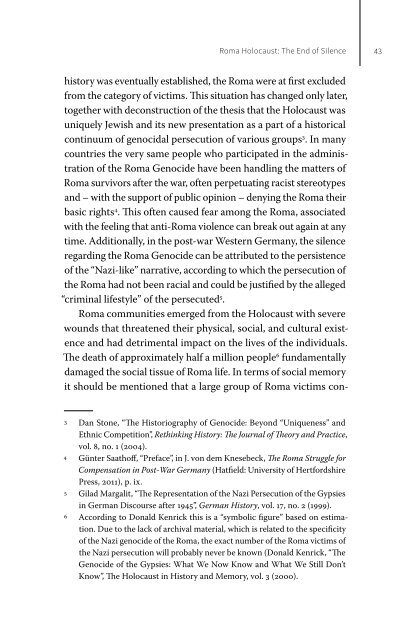EDUCATION FOR REMEMBRANCE OF THE ROMA GENOCIDE
Remembrance_2016
Remembrance_2016
Create successful ePaper yourself
Turn your PDF publications into a flip-book with our unique Google optimized e-Paper software.
Roma Holocaust: The End of Silence 43<br />
history was eventually established, the Roma were at first excluded<br />
from the category of victims. This situation has changed only later,<br />
together with deconstruction of the thesis that the Holocaust was<br />
uniquely Jewish and its new presentation as a part of a historical<br />
continuum of genocidal persecution of various groups 3 . In many<br />
countries the very same people who participated in the administration<br />
of the Roma Genocide have been handling the matters of<br />
Roma survivors after the war, often perpetuating racist stereotypes<br />
and – with the support of public opinion – denying the Roma their<br />
basic rights 4 . This often caused fear among the Roma, associated<br />
with the feeling that anti-Roma violence can break out again at any<br />
time. Additionally, in the post-war Western Germany, the silence<br />
regarding the Roma Genocide can be attributed to the persistence<br />
of the “Nazi-like” narrative, according to which the persecution of<br />
the Roma had not been racial and could be justified by the alleged<br />
“criminal lifestyle” of the persecuted 5 .<br />
Roma communities emerged from the Holocaust with severe<br />
wounds that threatened their physical, social, and cultural existence<br />
and had detrimental impact on the lives of the individuals.<br />
The death of approximately half a million people 6 fundamentally<br />
damaged the social tissue of Roma life. In terms of social memory<br />
it should be mentioned that a large group of Roma victims con-<br />
3 Dan Stone, “The Historiography of Genocide: Beyond “Uniqueness” and<br />
Ethnic Competition”, Rethinking History: The Journal of Theory and Practice,<br />
vol. 8, no. 1 (2004).<br />
4 Günter Saathoff, “Preface”, in J. von dem Knesebeck, The Roma Struggle for<br />
Compensation in Post-War Germany (Hatfield: University of Hertfordshire<br />
Press, 2011), p. ix.<br />
5 Gilad Margalit, “The Representation of the Nazi Persecution of the Gypsies<br />
in German Discourse after 1945”, German History, vol. 17, no. 2 (1999).<br />
6 According to Donald Kenrick this is a “symbolic figure” based on estimation.<br />
Due to the lack of archival material, which is related to the specificity<br />
of the Nazi genocide of the Roma, the exact number of the Roma victims of<br />
the Nazi persecution will probably never be known (Donald Kenrick, “The<br />
Genocide of the Gypsies: What We Now Know and What We Still Don’t<br />
Know”, The Holocaust in History and Memory, vol. 3 (2000).


